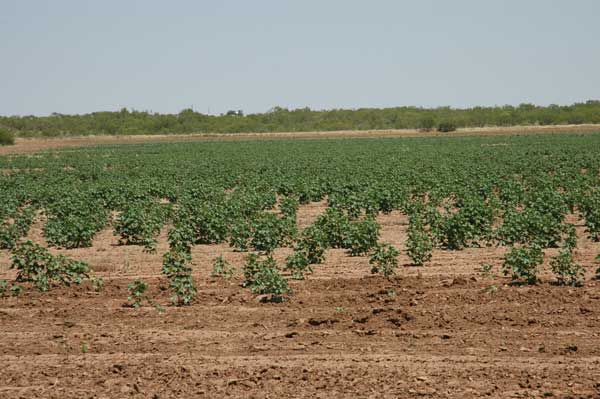
Great drought taking toll on Oklahoma cotton
Record breaking temperatures are still underway and based on recent forecasts will continue.It appears that we will have virtually no surviving dryland fields produce harvestable yield.Nearly all fields are ahead of schedule due to lack of rainfall, extreme deficit irrigation in many instances, and extreme heat.
August 26, 2011

The Great Drought of 2011 continues in Oklahoma with brutal effects. Record breaking temperatures are still underway and based on recent forecasts will continue. It appears that we will have virtually no surviving dryland fields produce harvestable yield. There may be some exceptions, but I have not seen any.
The surviving dryland program fields in which we tracked nodes above white flower (NAWF) had all bloomed through the terminal by August 16. These drought devastated fields are mature enough to be adjusted based on the boll count method at this time.
Five of eight program fields where NAWF have been tracked are in hard cutout (bloomed through the terminal) at this time, with three other fields at 2 to 3 NAWF. This means the window for setting yield potential is closing, especially when one considers the hot, dry forecast.
Because of the extreme environment, reduced yield due to fruit shed and small boll size will plague many irrigated fields this year.
Many factors are involved in this situation. Insect issues were not involved. Poor fruit retention can be attributed to heat stress and drought.Four-bract squares, “extruded stigmas” (where the stigma “punches through” the floral dome prior to petal exertion or some other blemish appears), and “parrot beaked” bolls (due to incomplete pollination) have all been noted in most fields.
Pollination of some bolls has been incomplete, evidently due to pollen sterility arising from high temperature stress. Sprinkler irrigation can result in incomplete pollination of some flowers, but I have seen this in furrow irrigated fields this year. This results in mis-shaped or “parrot beaked” bolls, caused by unequal seed numbers in all boll locules. Locules with higher seed counts grow and expand normally; those with fewer seed in the locules are smaller, which results in asymmetrical boll shape. I am attributing all of these fruit anomalies to the extremely high temperatures this year.
Some open cotton can be found in irrigated fields where early fruit was somehow retained. With the lower yield level (which is reminiscent of fair dryland cotton), these fields will be mature enough for harvest aid applications soon. However, in many other fields, the bottom and middle fruit has been shed.
In many fields nearly the entire “typical fruiting zone” associated with yield has been decimated by fruit shed and it appears that the struggle should be over for many irrigated fields. Extremely high crop evapotranspiration (ET) and declining irrigation capacity in many groundwater source fields have also had a severe negative impact on the overall situation.
Irrigation Termination
Nearly all fields are ahead of schedule due to lack of rainfall, extreme deficit irrigation in many instances, and extreme heat. For example, when long-term average heat units from May 25 for Altus are calculated using the “normal” (30-year dataset encompassing 1971-2000) temperature data, the total is 1,904 DD60s through August 22. This year, based on Mesonet data from the Altus station, the total from May 25-August 22 is 2,700. This compares to having an additional 30-year normal (730 heat units) month of July squeezed into the growing season. The actual heat unit accumulation between May 25 and August 22 is about 42 percent above normal.
Most irrigated cotton is well ahead of schedule and at or near the mature stage when all bolls that will contribute to ultimate yield are set, especially those fields that had severe deficit irrigation compared to crop ET.When one considers the COTMAN 50 percent probability date of August 20 for a bloom making a mature boll, much of this irrigated cotton is “finished.”
For more discussion on the COTMAN program see the August 8th issue of Cotton Comments.
Crop ET has been excessive based on the environment (solar radiation, temperatures and wind speed) and crop demand. Using Tipton Mesonet station data for a May 25 planted crop, since August 1 the amount of crop ET has totaled about 9.2 inches.
You May Also Like



